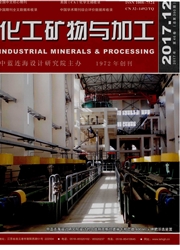

 中文摘要:
中文摘要:
本文对窑法磷酸磷矿还原渣矿化CO2进行了研究,着重考察了CO2压力、反应温度以及时间对钙的碳酸化沉淀率、碳酸化溶解率以及钙的总碳酸化率的影响,采用Aspen软件模拟不同矿化反应条件下溶液组成,并结合热力学计算对实验结果进行分析。研究结果表明,随着CO2压力的增加,钙的总碳酸化率增加,但是压力的影响并不显著;随着温度的升高,钙的总碳酸化率迅速增大,但是当温度超过75℃以后趋于稳定;随着反应时间的延长,钙的总碳酸化率逐渐升高,在30min以后趋于稳定。本研究中不同反应条件下钙的总碳酸化率均不超过61%,这可能是由于原料中以及反应产生的SiO2对未反应假硅灰石颗粒的包裹所致。研究发现,不同反应条件下钙的碳酸化溶解率占钙的总碳酸化率的比例在7%-34%之间变化,因此,在硅酸钙的CO2矿化研究中仅仅使用钙的碳酸化沉淀率来表征钙的碳酸化率,不考虑矿化液中以碳酸氢钙形式溶解的钙对矿化的贡献是不恰当的。
 英文摘要:
英文摘要:
In this paper, mineralization of CO2 with the phos- phate-reduced residue from kiln phosphoric acid (KPA) produc- tion was studied. The effects of operation conditions including CO2 initial pressure, reaction temperature and reaction time on the precipitation fraction, dissolution fraction of calcium through carbonation route and its total carbonation percentage were exam- ined. The experimental results were analyzed by combination of thermodynamic calculation with the solution chemical composi- tion obtained by simulation with commercial software Aspen Plus. It was shown that the total carbonation fraction of calcium gradually rose with increasing CO2 initial pressure, indicating in- significant impact of pressure. The total carbonation percentage increased rapidly with increasing reaction temperature. However, upon the temperature beyond 75 ℃, the curve became leveled off. With the extension of reaction time, the total carbonation percentage gradually rose and tended to be constant after 30 min. The highest total carbonation percentage obtained in the present study was only 61%. This is probably due to the coverage of sili- ca from raw material and reaction product on the surface of un-re- acted pseudowollastonite (Ca3 Si3 O9) particles. It was found that ratio of the carbonation dissolution to the total carbonation varied between 7% to 34%. Therefore, in the study on carbonation of calcium silicate it is unreasonable to define the carbonation percentage of calcium only with the carbonation precipitation percentage without taking account of the contribution of calcium dissolved in the form of calcium bicarbonate (Ca(HCO3)2 ).
 同期刊论文项目
同期刊论文项目
 同项目期刊论文
同项目期刊论文
 期刊信息
期刊信息
